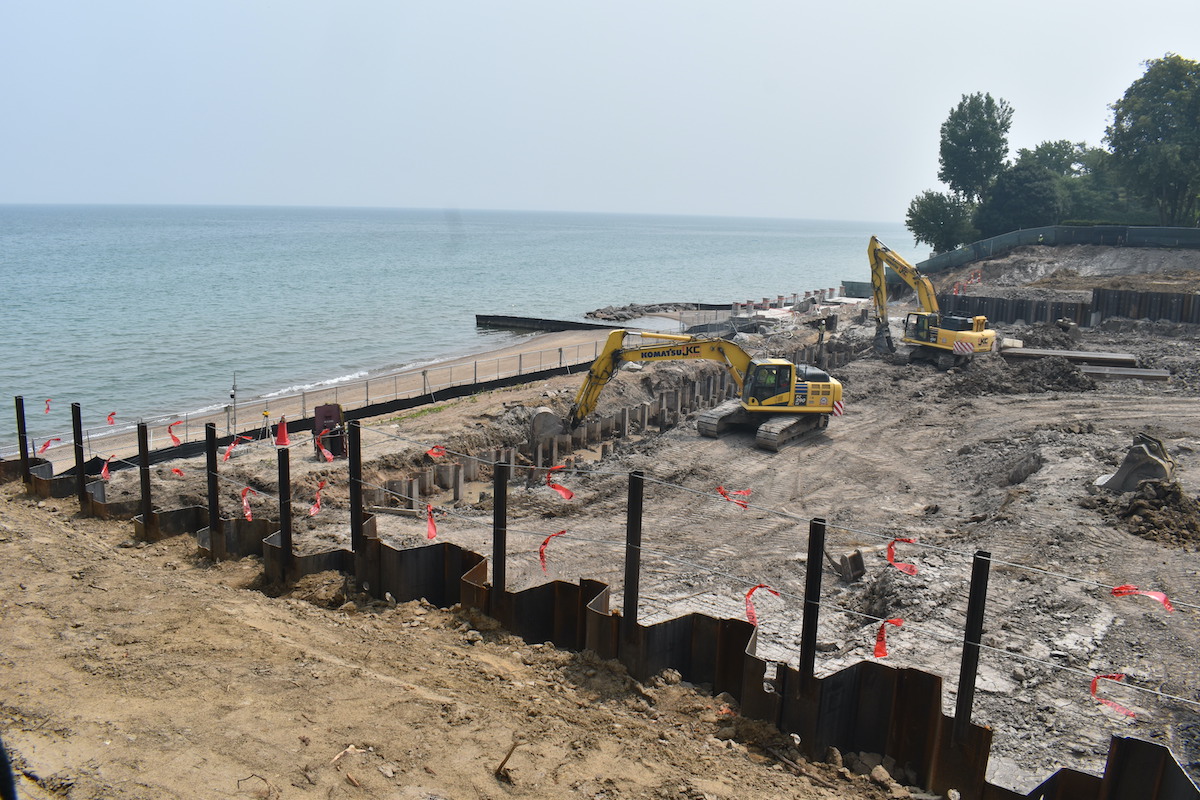
Restrictions on lot consolidation and building near bluffs are among Winnetka’s proposed regulations
Winnetka trustees continue to inch closer to specific regulations on beachfront development.
The Village Council met for a study session on Tuesday, Nov. 14, to again discuss the topic it has been workshopping for nearly a year.
Trustees agreed to move forward with a stricter review of lot consolidations, while requesting more information on potential measurements to define lot boundaries and bluffs — or steep slopes.
Village President Chris Rintz said he expects the discussion to continue in January, giving Village staff time to collect information and draft documents while also navigating the holiday season.
The council’s deep dive into its role in lakefront development was largely prompted by the ongoing, substantial project by property owner Justin Ishbia. As previously reported by The Record, Ishbia and his family have combined four Sheridan Road lots and razed three structures to build one massive property across the stretch of the land at 205 Sheridan Road.
Trustees have lamented that their control over the development was limited by “gaps” in the Village’s zoning regulations that allowed for the unique project. In a previous study session, on Sept. 12, Trustee Bob Dearborn said, “What happened down there is a catalyst for these conversations. We can’t ignore it. … We have been presented with an issue that is a gap in our process. I think we need to fix it.”
On Nov. 14, the conversation included more specificity. The council worked off village staff findings and suggestions that were included in a pre-session report.
Trustees spent minimal time discussing the further regulation of lot consolidation. They supported staff’s recommendation to require large lot consolidations to obtain a special-use permit. According to the proposal, a request that would more than double the overall size (square footage) or width of the minimum zoning requirements, which vary between residential districts, must file for a special use permit. Special use requests go before the Plan Commission, Zoning Board of Appeals and Village Council.
Village President Chris Rintz, responding to a resident’s question, said multi-lot consolidation can change the character of a neighborhood, a consequence the Village hopes to avoid.
“If you were to buy four or five lots and combine them into one and you built a 10,000- or 12,000-square-foot house in a neighborhood of 3,000-square-foot houses, it would consume the block face … much like the Ishbia property,” he said. “When you combine five lots together, it gave him the ability to build a very, very, very large structure. So by limiting the amount of land that can be combined together in a buildable parcel, you are fundamentally also controlling the size of what may ultimately go there when you do that combination.”
The conversation centering bluff protection was more nuanced.
The Village is hoping to adjust its lakeside lot boundary, which is the starting point for any setback regulation. In current code language, the boundary is defined as the water’s edge, which officials say changes regularly, making it difficult to regulate.
Instead, the Village is exploring using the Army Corps of Engineers Ordinary High Water Mark, a measurement of 581 1/2 feet elevation that has not changed since 1992. The OHWM, however, would be unique to each property and may be impacted by erosion, according to village documents.
Trustees requested more information on the OHWM and other possible boundary markers, which would impact where development could begin on the lot and thus, protect beachfront, potentially to include bluffs.
As for protections for the bluffs themselves, the Village wants to base its enhanced regulations on the Village of Glencoe’s steep slope ordinance, “which limits construction to certain structures such as stairs, decks, boathouses on and near the steep slope of the bluff subject to meeting geotechnical and structural engineering standards,” according to the meeting memo.
The memo continues, “The Council also expressed an interest in having the steep slope regulations promote best practices to ensure the preservation and addition of native vegetation for bluff stability, while promoting the removal of non-native species, which do not provide bluff stability, as well as invasive species.”
Winnetka’s ordinance would identify areas that are impactful to a property’s bluffs and protect them. According to a Village study, dozens of structures and amenities — from boathouses to walkways — currently in place on Winneka lakefront properties would not be allowed under a steep-slope ordinance. The study shows 79% of Winnetka’s lakefront homes have walkways or steps that would be nonconforming. Village staff says if an ordinance is put in place the structures could remain and be labeled “legally non-conforming.”
That isn’t to say no development would be allowed in steep-slope zones. The ordinance would require special-use permits and “exceptional engineering,” or advanced data, to proceed with certain construction. Applicants would need to meet a number of requirement and standards, such as providing subsoil reports, grading plans, vegetation plans, and more.
Winnetka resident Cynthia Hara, who lives along the lakefront, did not necessarily oppose the added regulations but requested the council consider the good intentions of beachfront property owners.
“When you are the owner of a property especially on the lakefront, the primary thing you want to do as you are building on it is you want to protect it,” she said. ” … The truth of it is, because I went through it, when you do it properly, when you have structural engineers … they take great pains to do things precisely.
Hara added, “I know not everyone can live on the lake; there’s not enough property, but I wish everyone could because it’s a blessing. Those of us who do live on the lake, we respect it, we take care of it, we are its caretaker, and we put our trust in all of you when you’re making these rules that you’ll think of us and how we live there too.”
The Record is a nonprofit, nonpartisan community newsroom that relies on reader support to fuel its independent local journalism.
Subscribe to The Record to fund responsible news coverage for your community.
Already a subscriber? You can make a tax-deductible donation at any time.

Joe Coughlin
Joe Coughlin is a co-founder and the editor in chief of The Record. He leads investigative reporting and reports on anything else needed. Joe has been recognized for his investigative reporting and sports reporting, feature writing and photojournalism. Follow Joe on Twitter @joec2319


